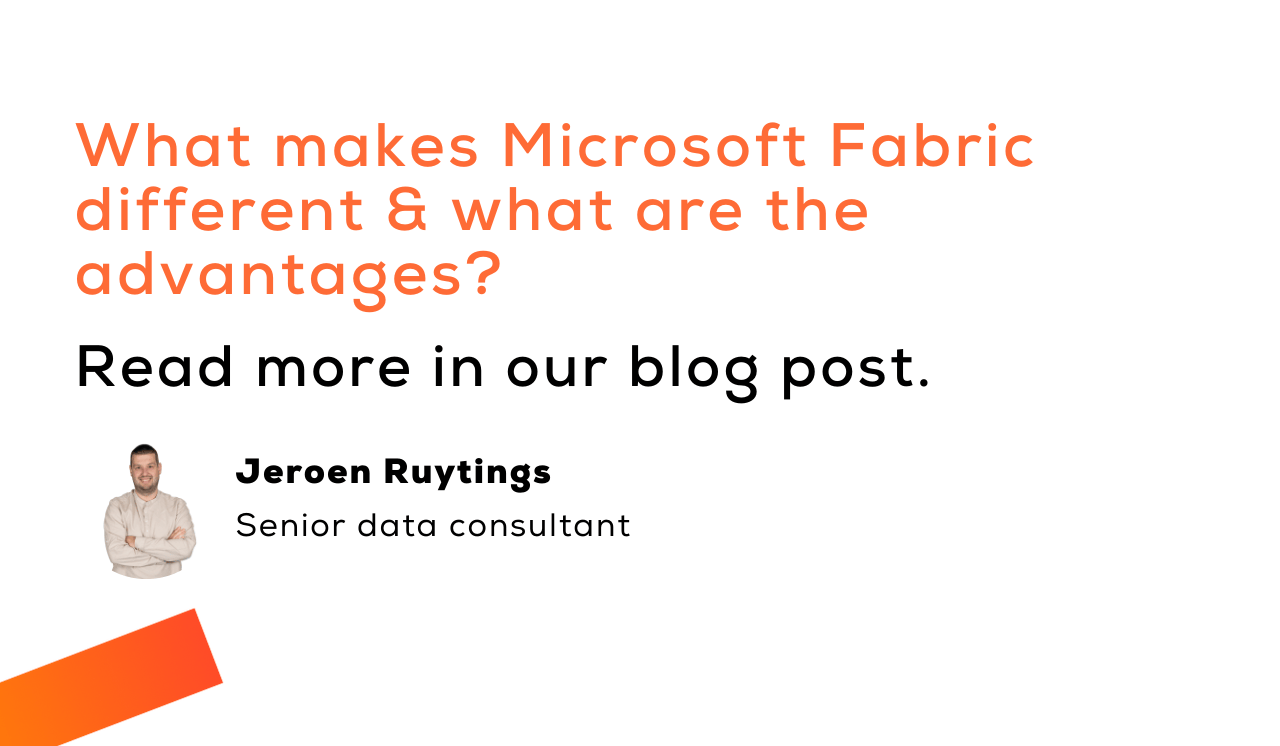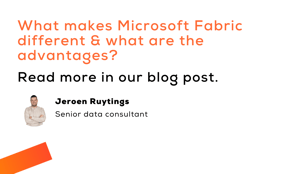
There’s are several reasons why Microsoft launched their unified data & AI platform. But what makes Microsoft Fabric more than just a rebranding of their current Microsoft Azure data offering?
Everything-as-a-service
You don’t need to worry or care about hardware, infrastructure, or complex administration any longer as everything is provided and setup for you. Integration and optimisation happen automatically (with some important caveats we’ll mention later).
A single platform and a single fee?
Microsoft Fabric brings together everything you need from data & AI in a single platform: from data engineering and integration to data governance and data security. It encompasses data science, real-time analytics business intelligence and AI capabilities. The platform is meant to give you a more coherent user experience, with a clear monthly fee.
Everything-on-one-platform
Data analytics typically consists of four key stages: collection, integration, analysis, and presentation. Microsoft Fabric allows you to combine them all on one platform.
Single source of data
Data will be stored in a single data lake and in a standardised format, eliminating unnecessary replication and enabling seamless integration with various (Microsoft) tools. This offers you a true single source of data.
Centralised administration
The overall idea is to govern one tenant, which contains all your organisation’s data artifacts. That means various data professionals across your organisation don’t need to worry about security or compliance challenges, as everything is handled in one place.
Low-code
The platform is built low-code with business users in mind. They can use the platform without having to turn to developers to tailor to their specific needs. Business is not blocked in their data analysis, while pro developers gain time to do more code-intensive tasks.
Personalised experience
Microsoft Fabric is experience-based, meaning users can interact with it depending on their roles and personas. A data engineer will get a different interface and tools then a data scientist or a business analyst for example.
What are the advantages?
Microsoft Fabric offers several advantages for businesses. We highlight the most important ones to give you a good idea of what Microsoft Fabric might have to offer your organisation.
1. Scalability
Microsoft Fabric is designed to accommodate the evolving needs of your business and can be easily scaled to meet your requirements. This is an important factor in staying competitive and adapting to change, as the platform allows you to expand or contract your resources as necessary to optimise your costs.
2. Single platform, different use
Microsoft Fabric has a single architecture that supports several types of solutions simultaneously. There is an environment to support data warehousing and reporting, another environment to support real-time analysis, and a third environment to facilitate data mining and AI.
3. Seamless integration with other Microsoft products
Microsoft Fabric seamlessly integrates with other Microsoft products and services, whether it’s Microsoft Azure, Office 365, or any other Microsoft tool. This integration saves time and reduces operational friction.
4. Cost efficiency
Microsoft Fabric helps optimise your IT costs. Since it is a SaaS platform, you can significantly reduce your capital expenses. The pay-for-use pricing model allows you to have a clear overview of your monthly IT expenditure. On top of that, you have a dedicated cost dashboard which makes it easy to monitor your budget.
If you're looking for further tips on how to help you reduce while using Microsoft Fabric, read our blogpost.
5. Optimised security
Microsoft Fabric provides robust security measures to protect your data and applications. It incorporates features such as identity and access management, data encryption, threat detection, and compliance management, all aimed at safeguarding your sensitive information.
6. High availability and reliability
As with every Saas platform these days, Microsoft Fabric boasts a high availability and reliability. This ensures that your critical applications and services are accessible 24/7, minimizing disruptions and keeping your operations running smoothly.
7. Automation and AI integration
Microsoft Fabric incorporates automation and artificial intelligence (AI) to streamline tasks and make data-driven decisions. You can automate routine processes, such as data backups and resource scaling or use AI-powered analytics and insights to make informed business decisions and gain a competitive edge in your industry.
8. Easily searchable and accesible data
Microsoft Fabric stresses the importance of data governance and makes data easily searchable and accesible via data catalog (Purview). You can easily create a holistic, up-to-date map of your data landscape with automated data discovery, sensitive data classification and end-to-end data lineage.
9. Integration with other cloud platforms
Microsoft Fabric’s ability to integrate data across various cloud services (Azure, AWS, Google Cloud, etc.) is a gamechanger. The platform allows for easy data querying of data without migration. Ths saves a lot of time and effort in consolidating data.
Need help with Microsoft Fabric?
Microsoft makes starting with Microsoft Fabric fairly easy. And the free trial period allows you to discover the platform and its possibilities. But when you are beyond this discovery phase the help of a seasoned partner with a track record (we’ve got the use cases to prove it) and expertise in the matter, might come in handy. As a Microsoft Solutions Partner in data & AI and Azure we can help you on different levels and in different stages of your data journey.
If you need help with Microsoft Fabric, fill out the form below to speak with one of our experts.





.png?width=66&name=Jeroen%20Ruytings%20(2).png)



